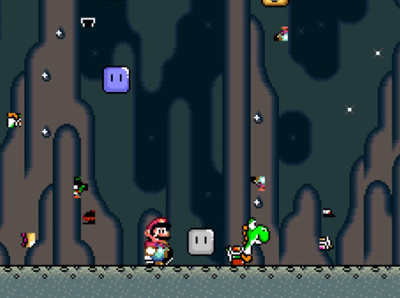Watch 'Super Mario World' Get Hacked Into 'Pong'
After years of hunting for glitches to exploit, players have discovered how to hack code into a ‘Super Mario World’ cartridge.


Sometimes when you play "Super Mario" games, the difficulty can get overwhelming. Have you ever wanted extra lives or extra super mushrooms?
Through clever use of glitches, such as graphical and gameplay errors in the game code, and pre-programmed inputs to control characters, this is possible. It is all routine in the world of tool-assisted gaming, where players use computer programs to give them extra control over video games. Not only that, but one player known as Masterjun has even used said glitches to hack into "Super Mario World" and run code, and all through the controller input ports.
At the Awesome Games Done Quick marathon showing off tool-assisted speedruns, Masterjun inserted a series of preprogrammed inputs into a Super Nintendo console running the game "Super Mario World." These controller inputs, such as movement on the directional pad or pressing specific buttons, are programmed to trigger on certain frames of animation, causing glitches that give Mario extra 1up mushrooms or multiple Yoshi dinosaurs, for example. That is a feat unto itself, but those glitches also allowed the player to add his own code.

First, the player causes the game to destroy and load items in a certain order. Then he causes a glitch that makes the game load an unused item that isn't supposed to be in the game. That in turn tricks the game into running the long and carefully planned series of items in the memory as an executable file. When that happens, the game reverts to accepting code from controller ports. Using cables that end with the inputs for two Super Nintendo multitap peripherals, Masterjun’s setup had a total of eight simulated controllers. That let Masterjun input enough code to run both a "Pong" and a "Snake" game using "Super Mario" art assets.
MORE: PS4 vs. Xbox One: Which Console Wins?
Players usually hack into games by changing programming or variables in the emulator software, which replicates a game console and its games on a computer. But doing it through exploiting glitches in a game to run code through controller ports is unique. The inputs for the controllers are pre-programmed, contained on a Raspberry Pi mini computer in this case. The inputs are connected to the Super Nintendo through some cables that end with the inputs for two Super Nintendo multitaps. With eight controllers' worth of inputs, there is enough time during the glitched frames to insert the code of the two minigames into the running "Super Mario World" game.
Typically, a tool-assisted speedrun happens when a player is playing a game through an emulator, using tools that change the speed of the game or save the state of the game mid-play. With such tools, complex glitches present in the game that require extremely precise control can be achieved and saved, allowing players to keep playing and reloading until they succeed on the next glitch and the next, and so on until those specific series of glitches allows someone to finish within minutes games that should take hours. You can find videos of such tool-assisted speedruns at TASVideos.org.
Get instant access to breaking news, the hottest reviews, great deals and helpful tips.
Source: TASVideos.org via Ars Technica
Follow Kevin Ohannessian at @khohannessian and on Google+. Follow us @tomsguide, on Facebook and on Google+.
Kelly Ohannessian is a freelance writer and editor. With more than 15 years of experience, she works with a focus on covering the creative aspects of the gaming industry. Her articles have appeared on Medium, Fast Company, Tom's Guide, Laptop Mag, Gamespot, and many more. Currently, she works as a manager at Brooklyn Game Lab.
-
chrisso This person masterjun should get a girlfriend or something. Join a library perhaps. I cant think of anything less interesting or pointless than hacking into 20 year old games,Reply
